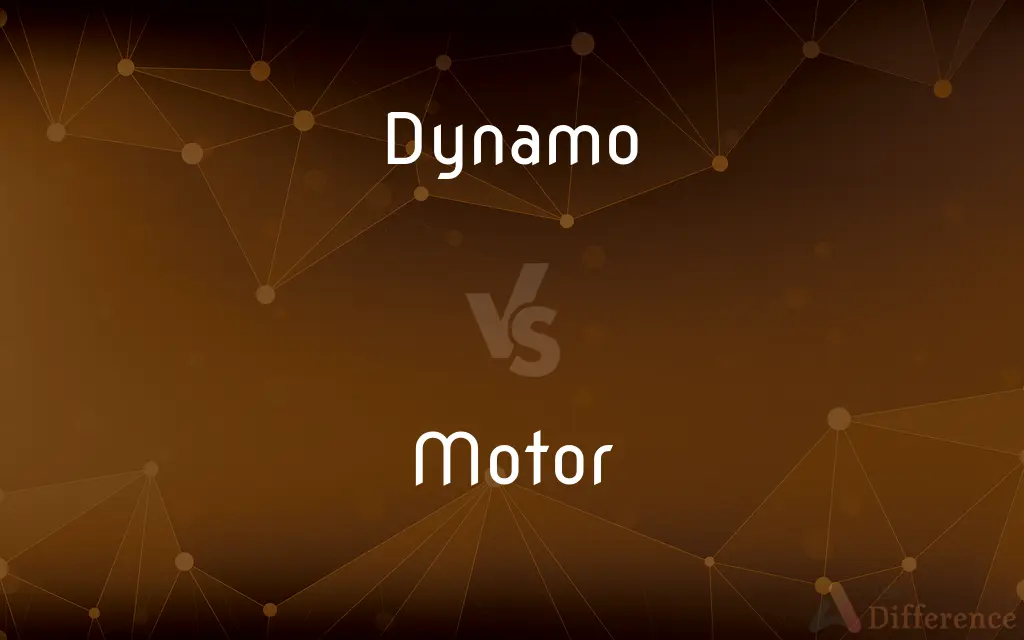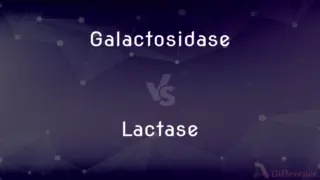Dynamo vs. Motor — What's the Difference?
By Fiza Rafique & Urooj Arif — Updated on April 5, 2024
A dynamo converts mechanical energy into electrical energy through electromagnetic induction, while a motor does the opposite, converting electrical energy into mechanical energy.

Difference Between Dynamo and Motor
Table of Contents
ADVERTISEMENT
Key Differences
A dynamo, also known as a generator, is a device designed to produce electrical power through the process of electromagnetic induction, where mechanical energy—often from manual operation or an engine—is converted into electrical energy. This electrical energy can then be used to power electrical devices or charge batteries. On the other hand, a motor is an electrical machine that converts electrical energy into mechanical energy, typically used to drive mechanical systems like fans, pumps, and vehicles. Motors are fundamental components in various applications, from household appliances to industrial machinery.
In terms of operation, dynamos generate electricity as their coils rotate within a magnetic field, inducing an electrical current according to Faraday's law of electromagnetic induction. Whereas motors work on the principle that a current-carrying conductor, placed in a magnetic field, experiences a force, thereby producing motion. This principle is effectively the reverse of the dynamo's operation.
From a historical perspective, dynamos were crucial in the early development of electrical power generation and distribution systems, providing a means to convert mechanical power from steam engines or water turbines into electrical power. Motors, conversely, have been instrumental in the automation and mechanization of labor, transforming electrical power back into mechanical form to do work.
While both devices are pivotal in the field of electromechanics, their applications diverge significantly. Dynamos are primarily found in power generation settings or as components of systems requiring the conversion of mechanical to electrical energy, such as in bicycles with dynamo-powered lights. Motors, however, are ubiquitous in virtually every sector that requires mechanical movement derived from electrical sources.
The efficiency of these devices is a key area of difference. Dynamos are designed to maximize the conversion of mechanical energy into electrical energy with as little loss as possible. Motors, however, are optimized for converting electrical energy into mechanical energy efficiently and effectively, with advancements in technology continually improving their performance and energy consumption.
ADVERTISEMENT
Comparison Chart
Function
Converts mechanical energy into electrical energy.
Converts electrical energy into mechanical energy.
Principle of Operation
Electromagnetic induction.
Electromagnetic force on current-carrying conductors.
Main Use
Power generation.
Driving mechanical systems.
Historical Significance
Early development of electrical power generation.
Automation and mechanization of labor.
Efficiency
Maximizes conversion of mechanical to electrical energy.
Optimizes conversion of electrical to mechanical energy.
Compare with Definitions
Dynamo
A dynamo generates electrical energy from mechanical motion.
The bicycle's lights are powered by a dynamo that generates electricity as the wheels turn.
Motor
A motor converts electrical energy into mechanical motion.
The washing machine's drum is turned by an electric motor.
Dynamo
It utilizes electromagnetic induction to produce power.
Early power stations used large dynamos to generate electricity.
Motor
It operates by electromagnetic force.
Motors in electric vehicles convert electrical power from batteries into motion.
Dynamo
Dynamos are often used in off-grid power generation.
Hand-cranked dynamos can power radios or lights in remote areas.
Motor
Motors drive countless mechanical systems.
From household appliances to industrial machines, motors are key to operation.
Dynamo
They were foundational in developing electrical distribution systems.
Dynamos were once the heart of the world's first power plants.
Motor
The efficiency of motors impacts energy consumption and performance.
High-efficiency motors reduce energy costs and environmental impact.
Dynamo
A dynamo's efficiency is crucial for effective power generation.
Modern dynamos are designed to minimize energy loss during conversion.
Motor
They have revolutionized automation across industries.
Assembly lines are largely automated through the use of electric motors.
Dynamo
A dynamo is an electrical generator that creates direct current using a commutator. Dynamos were the first electrical generators capable of delivering power for industry, and the foundation upon which many other later electric-power conversion devices were based, including the electric motor, the alternating-current alternator, and the rotary converter.
Motor
Something, such as a machine or an engine, that produces or imparts motion.
Dynamo
A generator, especially one for producing direct current.
Motor
A device that converts any form of energy into mechanical energy, especially an internal-combustion engine or an arrangement of coils and magnets that converts electric current into mechanical power.
Dynamo
An extremely energetic and forceful person
A vice president who was the real dynamo of the corporation.
Motor
A motor vehicle, especially an automobile
"It was a night of lovers. All along the highway ... motors were parked and dim figures were clasped in revery" (Sinclair Lewis).
Dynamo
(electromagnetism) An electricity generator; a dynamo-electric machine.
Motor
Causing or producing motion
Motor power.
Dynamo
(astrophysics) The mechanism by which a celestial body, such as the Earth or a star, generates a magnetic field.
Motor
Driven by or having a motor.
Dynamo
(figuratively) An energetic person.
That new Vice President of Marketing is a real dynamo; sales have already gone up this quarter.
Motor
Of or for motors or motor vehicles
Motor oil.
Dynamo
A dynamo-electric machine.
Motor
Of, relating to, or designating nerves that carry impulses from the nerve centers to the muscles.
Dynamo
Generator consisting of a coil (the armature) that rotates between the poles of an electromagnet (the field magnet) causing a current to flow in the armature
Motor
Involving or relating to movements of the muscles
Motor coordination.
A motor reflex.
Motor
To drive or travel in a motor vehicle.
Motor
To carry by motor vehicle.
Motor
A machine or device that converts other energy forms into mechanical energy, or imparts motion.
Motor
(colloquial) A motor car, or automobile, even a goods vehicle.
Nice motor!
Motor
(figuratively) A source of power for something; an inspiration; a driving force.
Motor
Any protein capable of converting chemical energy into mechanical work.
Motor
The controller or prime mover of the universe; God.
Motor
(prison slang) The fermenting mass of fruit that is the basis of pruno, or "prison wine".
Motor
(biology) Relating to the ability to move.
She has excellent motor skills.
Motor
Relating to motor cars.
Motor insurance is expensive for youngsters.
Motor
(nautical) Propelled by an internal combustion engine as opposed to a steam engine or turbine.
Motor
(dated) To make a journey by motor vehicle; to drive.
On Saturday we motored down to Plymouth.
Motor
To rotate a jet engine or turboprop using the engine's starter, without introducing fuel into the engine.
During startup, the engine should be motored for 20 to 30 seconds to allow the shafts to straighten out, as they may have become bowed under their own weight while the airplane was sitting on the ground.
Motor
To progress at a brisk pace.
Sales were slow at first, but now things are really motoring.
Motor
(slang) To leave.
I gotta motor.
Motor
One who, or that which, imparts motion; a source of mechanical power.
Motor
A prime mover; a machine by means of which a source of power, as steam, moving water, electricity, etc., is made available for doing mechanical work.
Motor
A motor car; an automobile.
Motor
Causing or setting up motion; pertaining to organs of motion; - applied especially in physiology to those nerves or nerve fibers which only convey impressions from a nerve center to muscles, thereby causing motion.
Motor
Machine that converts other forms of energy into mechanical energy and so imparts motion
Motor
A nonspecific agent that imparts motion;
Happiness is the aim of all men and the motor of all action
Motor
Travel or be transported in a vehicle;
We drove to the university every morning
They motored to London for the theater
Motor
Conveying information to the muscles from the CNS;
Motor nerves
Motor
Causing or able to cause motion;
A motive force
Motive power
Motor energy
Common Curiosities
How do dynamos and motors contribute to sustainable energy solutions?
Dynamos can be part of renewable energy systems (e.g., wind turbines), and efficient motors reduce electricity consumption in various applications.
Are there different types of motors?
Yes, there are many types, including AC motors, DC motors, stepper motors, and servo motors, each suited to specific applications based on speed, torque, and control requirements.
What is the significance of efficiency in dynamos and motors?
Efficiency determines how much of the input energy is converted to useful output, affecting performance, cost, and environmental impact.
How has the technology behind dynamos and motors evolved?
Advances include improvements in materials, design, and control systems, leading to greater efficiency, reliability, and application in fields like renewable energy and electric vehicles.
What role do dynamos and motors play in electric vehicles?
Motors are critical for converting electrical energy from batteries into the mechanical energy that drives the vehicle, while dynamos are used in regenerative braking systems to generate electricity.
How do the principles of operation for dynamos and motors relate?
They are based on electromagnetic induction and force, respectively, representing inverse processes in electromechanics.
Can a motor also generate electricity?
Yes, many motors can act as generators when mechanically driven, but they are optimized for converting electricity to mechanical motion.
What distinguishes a dynamo from an alternator?
A dynamo produces direct current (DC) electricity, whereas an alternator generates alternating current (AC) and is more efficient for use in automotive and power generation applications.
Can the efficiency of dynamos and motors be improved?
Yes, ongoing research into materials, electromagnetic designs, and control algorithms continually seeks to improve their efficiency and reduce losses.
What are practical examples of motor applications in daily life?
Motors are used in appliances (blenders, fans), tools (drills, saws), vehicles (cars, drones), and many other applications requiring motion.
Why are dynamos less common in modern power generation?
Alternators have largely replaced dynamos in power generation due to their ability to produce AC power more efficiently and effectively.
How do environmental conditions affect the performance of dynamos and motors?
Conditions like temperature, humidity, and dust can affect efficiency and lifespan, with designs often tailored to specific environmental requirements.
What innovations are shaping the future of motor technology?
Innovations include the development of brushless DC motors for greater efficiency and reliability, and the integration of smart technologies for improved performance monitoring and control.
What maintenance do dynamos and motors require?
Maintenance can include lubrication, cleaning, and checking for wear and tear on components like brushes and bearings to ensure optimal performance.
How do dynamos and motors impact industrial automation?
They are fundamental to automation, enabling the mechanization of processes that significantly increase productivity and efficiency in manufacturing and other industrial sectors.
Share Your Discovery

Previous Comparison
Galactosidase vs. Lactase
Next Comparison
Ruffle vs. ShuffleAuthor Spotlight
Written by
Fiza RafiqueFiza Rafique is a skilled content writer at AskDifference.com, where she meticulously refines and enhances written pieces. Drawing from her vast editorial expertise, Fiza ensures clarity, accuracy, and precision in every article. Passionate about language, she continually seeks to elevate the quality of content for readers worldwide.
Co-written by
Urooj ArifUrooj is a skilled content writer at Ask Difference, known for her exceptional ability to simplify complex topics into engaging and informative content. With a passion for research and a flair for clear, concise writing, she consistently delivers articles that resonate with our diverse audience.














































